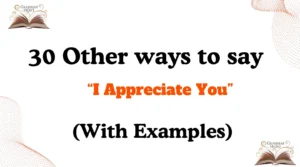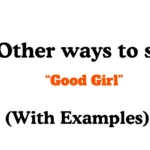When we say “no worries”, it’s usually meant to show kindness, care, and reassurance. It helps someone feel that they don’t need to stress, apologize, or overthink. But sometimes, using different alternatives can make your message feel more personal, thoughtful, or professional. Choosing the right words allows you to connect better—whether you’re chatting with a friend, comforting a loved one, or writing to a colleague.
In this guide, we’ll look at 30 warm and meaningful ways to say “no worries,” each with scenarios, examples, tone, and explanations to help you use them naturally.
What Does “No Worries” Mean?
The phrase “no worries” simply means “everything is fine”, “don’t worry about it”, or “it’s okay.” It’s a way to tell someone that you’re not upset or bothered.
Is It Professional/Polite to Say “No Worries”?
Yes, “no worries” is polite, but it can sometimes sound too casual, especially in workplace emails or formal communication. In professional situations, alternatives like “not a problem at all” or “everything is taken care of” may sound more suitable.
Pros or Cons
Pros:
- Warm, friendly, and reassuring
- Easy to use in both spoken and written English
- Helps ease guilt or pressure
Cons:
- Can sound too informal in business settings
- Repetitive if overused
- Some people may misinterpret it as dismissive
Synonyms For “No Worries”
- No Problem
- It’s Okay
- Don’t Mention It
- Anytime
- It’s Nothing
- Not a Problem
- You’re Welcome
- No Big Deal
- All Good
- No Harm Done
- Don’t Worry About It
- Forget About It
- That’s Fine
- No Stress
- It’s All Right
- No Trouble
- Glad to Help
- It Was Nothing
- Think Nothing of It
- Not an Issue
- You’re Fine
- No Sweat
- My Pleasure
- Of Course
- Don’t Give It a Second Thought
- No Need to Apologize
- It Happens
- All Is Well
- That’s Alright
- No Inconvenience
1. No Problem
Scenario: When someone apologizes for being late.
- Example 1: “No problem at all, I totally understand.”
- Example 2: “That’s no problem, I had some emails to finish anyway.”
- Example 3: “It’s no problem, happy to wait.”
Tone: Friendly and casual.
Explanation: This phrase shows understanding and patience. It works well in both everyday conversations and professional replies.
2. It’s Okay
Scenario: When someone worries about making a mistake.
- Example 1: “It’s okay, everyone makes mistakes.”
- Example 2: “It’s okay, no need to stress about it.”
- Example 3: “It’s okay, we can fix it together.”
Tone: Reassuring and gentle.
Explanation: This phrase helps the other person feel safe and accepted, lowering their sense of guilt or worry.
3. Don’t Mention It
Scenario: When someone thanks you for a small favor.
- Example 1: “Don’t mention it, I was happy to help.”
- Example 2: “Really, don’t mention it—it was nothing.”
- Example 3: “Don’t mention it, anytime.”
Tone: Lighthearted and modest.
Explanation: It shows that what you did wasn’t a big deal and you’re happy to help. Often used in friendly conversations.
4. Anytime
Scenario: When someone appreciates your support.
- Example 1: “Anytime, I’ll always be here for you.”
- Example 2: “Anytime, just give me a call.”
- Example 3: “Of course, anytime!”
Tone: Warm and inviting.
Explanation: This communicates openness and willingness to help again in the future, making the relationship feel stronger.
5. It’s Nothing
Scenario: When someone feels bad for troubling you.
- Example 1: “It’s nothing, don’t worry about it.”
- Example 2: “It’s nothing at all, happy to help.”
- Example 3: “It’s nothing, really.”
Tone: Casual and caring.
Explanation: This reassures the other person that you don’t see their request or mistake as a burden.
6. Not a Problem
Scenario: When a colleague apologizes for asking a last-minute question.
- Example 1: “Not a problem, I can look into it right now.”
- Example 2: “That’s not a problem, I’m glad you asked.”
- Example 3: “Not a problem at all, it’s part of my job.”
Tone: Professional and polite.
Explanation: This works well in formal settings. It communicates that you’re not inconvenienced, while still sounding respectful.
7. You’re Welcome
Scenario: When someone thanks you sincerely.
- Example 1: “You’re welcome, happy to help anytime.”
- Example 2: “You’re welcome, glad it worked out.”
- Example 3: “You’re welcome, don’t hesitate to ask again.”
Tone: Polite and appreciative.
Explanation: A traditional response that fits both formal and informal conversations. It shows acknowledgment and respect.
8. No Big Deal
Scenario: When a friend says sorry for forgetting something.
- Example 1: “No big deal, I forgot too.”
- Example 2: “No big deal, we’ll figure it out tomorrow.”
- Example 3: “It’s no big deal, don’t stress about it.”
Tone: Relaxed and casual.
Explanation: This helps minimize the situation, making it sound less important than the person might think.
9. All Good
Scenario: When someone worries about canceling plans.
- Example 1: “All good, we can reschedule.”
- Example 2: “All good, I completely understand.”
- Example 3: “All good, take care of yourself first.”
Tone: Friendly and laid-back.
Explanation: This phrase shows flexibility and understanding. It’s very common in casual conversations.
10. No Harm Done
Scenario: When someone apologizes for a small mistake.
- Example 1: “No harm done, it happens to everyone.”
- Example 2: “Really, no harm done—I barely noticed.”
- Example 3: “No harm done, nothing was affected.”
Tone: Forgiving and reassuring.
Explanation: It emphasizes that the mistake caused no damage, so the other person doesn’t need to feel guilty.
11. Don’t Worry About It
Scenario: When a teammate apologizes for being late to a meeting.
- Example 1: “Don’t worry about it, we just started.”
- Example 2: “Don’t worry about it, you’re here now.”
- Example 3: “Don’t worry about it, we’ll catch you up.”
Tone: Compassionate and calming.
Explanation: This is direct and caring, helping the other person move past their worry quickly.
12. Forget About It
Scenario: When someone feels guilty about a small issue.
- Example 1: “Forget about it, it’s not important.”
- Example 2: “Forget about it, I’ve already moved on.”
- Example 3: “Forget about it, no need to stress.”
Tone: Light and casual.
Explanation: This shows the issue isn’t worth stressing over. Works best in informal settings, not professional ones.
13. That’s Fine
Scenario: When someone asks if you’re okay with a delay.
- Example 1: “That’s fine, I can wait.”
- Example 2: “That’s fine, take your time.”
- Example 3: “That’s fine, I completely understand.”
Tone: Neutral and polite.
Explanation: This phrase is simple and flexible. It works in most everyday conversations without sounding too casual.
14. No Stress
Scenario: When a friend apologizes for changing plans.
- Example 1: “No stress, we’ll do it another time.”
- Example 2: “No stress at all, I wasn’t busy.”
- Example 3: “No stress, really—it’s fine.”
Tone: Easygoing and relaxed.
Explanation: A very casual phrase often used with friends to lighten the mood and ease tension.
15. It’s All Right
Scenario: When someone admits they made a mistake.
- Example 1: “It’s all right, we’ll fix it.”
- Example 2: “It’s all right, no one’s perfect.”
- Example 3: “It’s all right, don’t worry.”
Tone: Gentle and forgiving.
Explanation: A soft way to reassure someone and let them know the mistake isn’t serious.
16. No Trouble
Scenario: When someone says thanks for your effort.
- Example 1: “No trouble at all, glad I could help.”
- Example 2: “It was no trouble, really.”
- Example 3: “No trouble, I enjoyed doing it.”
Tone: Courteous and professional.
Explanation: A polite way to show that what you did wasn’t a burden. Works especially well in business or formal conversations.
17. Glad to Help
Scenario: When someone appreciates your support.
- Example 1: “Glad to help, let me know if you need more.”
- Example 2: “Always glad to help a friend.”
- Example 3: “Glad to help anytime.”
Tone: Warm and encouraging.
Explanation: This phrase communicates willingness and kindness, making the other person feel supported.
18. It Was Nothing
Scenario: When someone says you went out of your way for them.
- Example 1: “It was nothing, don’t even mention it.”
- Example 2: “It was nothing, I’m happy you’re okay.”
- Example 3: “It was nothing, really.”
Tone: Humble and modest.
Explanation: Shows that your help wasn’t a big effort for you, reducing the other person’s sense of obligation.
19. Think Nothing of It
Scenario: When someone thanks you repeatedly.
- Example 1: “Think nothing of it, you’d do the same for me.”
- Example 2: “Please, think nothing of it—it was simple.”
- Example 3: “Think nothing of it, I’m always here.”
Tone: Old-fashioned but kind.
Explanation: A gentle way to downplay your effort, making the other person feel at ease.
Read More:30 Other Ways to Say ‘Please Advise’ (With Examples)
20. Not an Issue
Scenario: When someone worries about causing inconvenience.
- Example 1: “Not an issue, I had time to spare.”
- Example 2: “That’s not an issue at all, don’t worry.”
- Example 3: “Not an issue—we can handle it easily.”
Tone: Professional and calm.
Explanation: A reassuring phrase for workplace or formal settings, making you sound accommodating and supportive.
21. You’re Fine
Scenario: When someone apologizes for a small error.
- Example 1: “You’re fine, no need to say sorry.”
- Example 2: “You’re fine, it happens.”
- Example 3: “You’re fine, don’t overthink it.”
Tone: Relaxed and comforting.
Explanation: A casual phrase that reassures someone they don’t need to worry about their mistake.
22. No Sweat
Scenario: When a friend thanks you for a small favor.
- Example 1: “No sweat, it was super easy.”
- Example 2: “No sweat, happy to help.”
- Example 3: “No sweat at all, don’t mention it.”
Tone: Fun and informal.
Explanation: Common in casual speech, it shows the task was effortless and no burden.
23. My Pleasure
Scenario: When someone sincerely thanks you.
- Example 1: “My pleasure, I’m glad I could help.”
- Example 2: “It was my pleasure to be there.”
- Example 3: “My pleasure, anytime.”
Tone: Polite and respectful.
Explanation: A professional yet warm response that emphasizes you were happy to help.
24. Of Course
Scenario: When someone feels bad asking for help.
- Example 1: “Of course, I’ll do it for you.”
- Example 2: “Of course, happy to help anytime.”
- Example 3: “Of course, don’t even worry about it.”
Tone: Friendly and supportive.
Explanation: Suggests that helping was natural and expected, putting the other person at ease.
25. Don’t Give It a Second Thought
Scenario: When someone apologizes over and over.
- Example 1: “Don’t give it a second thought, it’s fine.”
- Example 2: “Don’t give it a second thought, I’ve forgotten it already.”
- Example 3: “Don’t give it a second thought, really.”
Tone: Gentle and forgiving.
Explanation: This phrase helps stop unnecessary guilt and shows you’ve moved past the issue.
26. No Need to Apologize
Scenario: When someone says sorry for bothering you.
- Example 1: “No need to apologize, I don’t mind at all.”
- Example 2: “No need to apologize, you’re not interrupting.”
- Example 3: “No need to apologize, it’s totally fine.”
Tone: Understanding and kind.
Explanation: Reassures the other person that they haven’t caused harm, useful in both casual and professional settings.
27. It Happens
Scenario: When someone makes a mistake at work.
- Example 1: “It happens, don’t worry too much.”
- Example 2: “It happens, everyone slips sometimes.”
- Example 3: “It happens, we’ll fix it together.”
Tone: Compassionate and forgiving.
Explanation: Normalizes mistakes, helping the person feel less embarrassed or guilty.
28. All Is Well
Scenario: When someone is anxious about a situation.
- Example 1: “All is well, no harm done.”
- Example 2: “All is well, everything’s under control.”
- Example 3: “All is well, don’t stress.”
Tone: Calm and reassuring.
Explanation: This phrase communicates peace and comfort, making the person feel everything is okay.
29. That’s Alright
Scenario: When someone says sorry for missing something.
- Example 1: “That’s alright, we can try again later.”
- Example 2: “That’s alright, I understand.”
- Example 3: “That’s alright, no problem at all.”
Tone: Relaxed and understanding.
Explanation: A common, polite way to reassure someone without making them feel guilty.
30. No Inconvenience
Scenario: When someone feels like they caused extra work.
- Example 1: “No inconvenience, I was already on it.”
- Example 2: “No inconvenience at all, really.”
- Example 3: “No inconvenience, glad to help.”
Tone: Professional and respectful.
Explanation: Works well in formal communication, showing that their request didn’t cause any trouble.
Conclusion
Finding the right words instead of always saying “no worries” can make your communication feel more kind, thoughtful, and professional. Whether you’re talking to a friend, family member, or colleague, these alternatives help you show understanding and care while keeping the conversation positive.

Mia Rose is a skilled language expert with a deep passion for helping individuals master the art of writing and communication. With years of experience in the field, Marie brings a thoughtful and tailored approach to grammar, style, and language improvement. Her goal is to empower others to express themselves with clarity, precision, and confidence in every written word.













